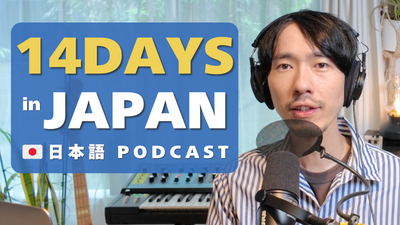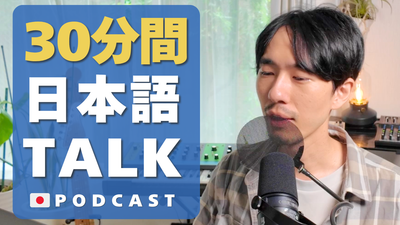Vocabulary
- 言い間違える(いいまちがえる)— to misspeak(N3)
例:配信の最初で言い間違えても大丈夫。
EN: It’s okay even if you misspeak at the start of a stream. - 字幕(じまく)— subtitles(N3)
例:有料アプリで字幕の品質を上げた。
EN: A paid app improved the quality of the subtitles. - 有料(ゆうりょう)— paid/fee-based(N3)
例:このツールは有料だが、時短になる。
EN: This tool is paid, but it saves time. - 能力(のうりょく)— ability(N3)
例:アプリで字幕作成の能力を手に入れた。
EN: I gained the ability to make subtitles with the app. - 先入観(せんにゅうかん)— preconception(N2)
例:間違いを恐れるという先入観を手放す。
EN: Let go of the preconception of fearing mistakes. - 伝わる(つたわる)— to be understood/conveyed(N3)
例:完璧じゃなくても意味は伝わる。
EN: Even if it’s not perfect, the meaning gets across. - 諦める(あきらめる)— to give up(N3)
例:文法で迷っても諦めないで話す。
EN: Don’t give up speaking even if grammar confuses you. - フィードバック — feedback(N3外)
例:間違えればフィードバックがもらえる。
EN: If you make mistakes, you get feedback. - 記憶に残る(きおくにのこる)— to stick in memory(N2)
例:会話での失敗は記憶に残る。
EN: Failures in conversation stick in your memory. - 文脈(ぶんみゃく)— context(N2)
例:文脈と感情が単語を強く定着させる。
EN: Context and emotions cement vocabulary. - 当たり障りがない(あたりさわりがない)— inoffensive(N1)
例:当たり障りがない言い方だけでは自然さが足りない。
EN: Speaking only in inoffensive ways lacks naturalness.
Phrases
1) どんどん間違えよう。
Meaning: “Let’s keep making mistakes (actively).”
どんどん means quickly, without hesitation, showing energy or momentum.
間違えよう is the “let’s” form (volitional), expressing motivation or self-encouragement.
It’s like saying, “Don’t hold back — make mistakes and learn from them!”
2) 間違うと成長できるんですね。
Meaning: “When you make mistakes, you’re able to grow.”
~と here means “when” or “if,” describing what happens as a result.
成長できる means “can grow” — it’s the potential form of 成長する (to grow).
The sentence connects cause and effect: mistakes → growth.
3) 失敗は学びの近道だ。
Meaning: “Failure is a shortcut to learning.”
失敗 means “failure” or “mistake.”
近道だ literally means “is a shortcut.”
This uses a metaphor: failure gets you to learning faster, just like a shortcut on a map.
4) 恥ずかしくても、とにかく話してみよう。
Meaning: “Even if it’s embarrassing, let’s just try speaking.”
~ても means “even if.”
話してみよう combines “to speak” + “try” + “let’s,” encouraging practice.
It means: don’t worry about mistakes — the best way to improve is to try speaking anyway.
5) 間違いからのフィードバックは記憶に残りやすい。
Meaning: “Feedback from mistakes tends to stick in your memory.”
からの means “from” or “coming from.”
~やすい means “easy to,” or “tends to.”
So, the sentence says mistakes help memory — because you remember them better when you get feedback.
Summaries
N5–N4(やさしい)
この話は、間違えても大丈夫、たくさん話してフィードバックをもらい、成長しようという内容です。
EN: This talk says it’s okay to make mistakes; speak a lot, get feedback, and grow.
言い間違えは記憶に残るから、文脈といっしょに言葉を覚えられます。
EN: Misspeaking sticks in your memory, so you learn words with context.
教科書だけでは自然な言い方が少ないので、会話でたくさん練習しましょう。
EN: With only textbooks, natural phrasing is limited, so practice a lot in real conversations.
N3–N2(ふつう)
話者は、有料アプリで字幕品質を上げつつ、学習者には「恐れずに間違え、話して直す」姿勢を勧めます。
EN: While improving subtitle quality with a paid app, the speaker urges learners to make mistakes without fear, speak, and then correct.
会話での失敗は感情と文脈に結びつき、記憶定着を強めます。
EN: Conversation slip-ups tie to emotions and context, strengthening memory retention.
また、教科書的な無難さだけでは自然さが欠けるため、生の言語に触れつつ量を話して質を上げるべきだと結論づけます。
EN: Since purely textbook-like safety lacks naturalness, he concludes we should boost quality by speaking more and engaging with real language.
N2–N1(ややむずかしい/自然寄り)
主張は一貫して、誤りは学習の燃料だという点にあります。
EN: The thesis is consistent: error is the fuel of learning.
即時のフィードバックと、失敗時の感情・文脈が想起を強化し、表現は実践の反復で洗練されます。
EN: Immediate feedback plus the emotion and context of failure enhance recall, and expression is refined through repeated practice.
さらに、角の取れた教科書日本語に偏らず、日常会話の揺らぎや新奇性を取り込み、量から質への変換を促すことが、自然で生産的な習得につながると説きます。
EN: He argues that going beyond rounded textbook Japanese—embracing the variability and freshness of daily talk—turns quantity into quality, leading to more natural, productive language learning.






Member discussion